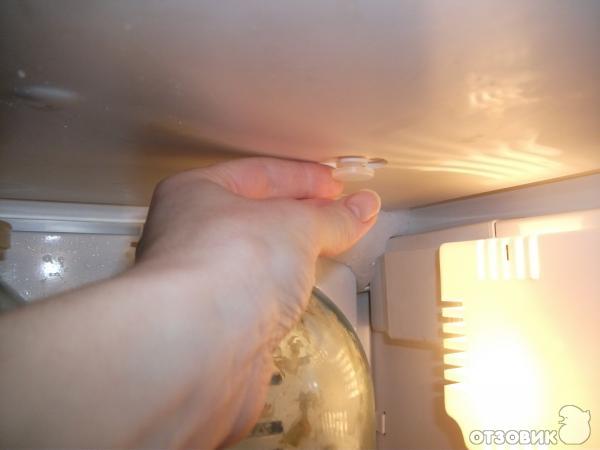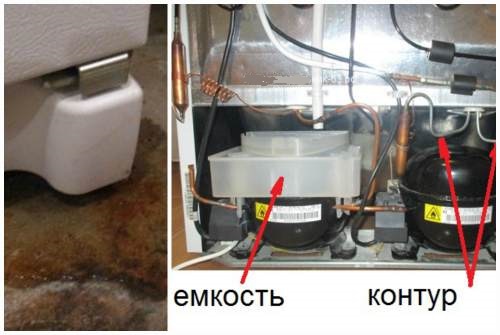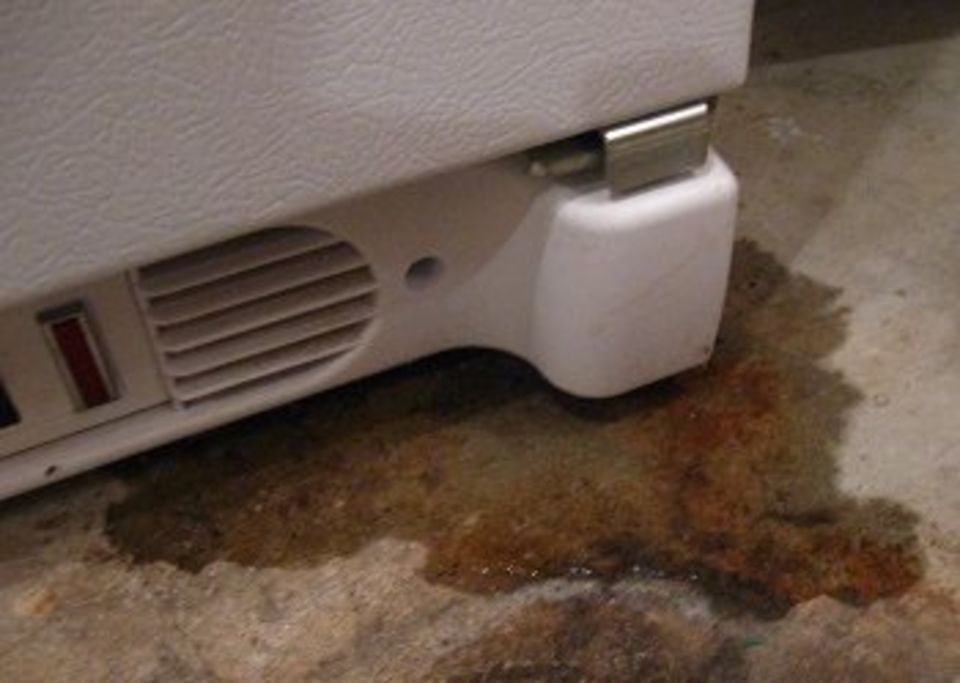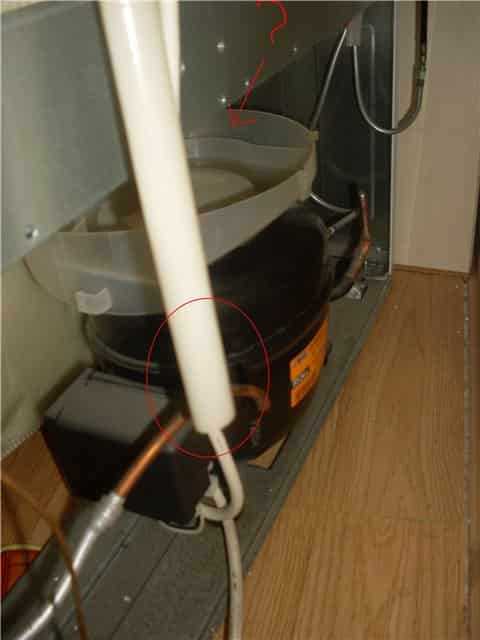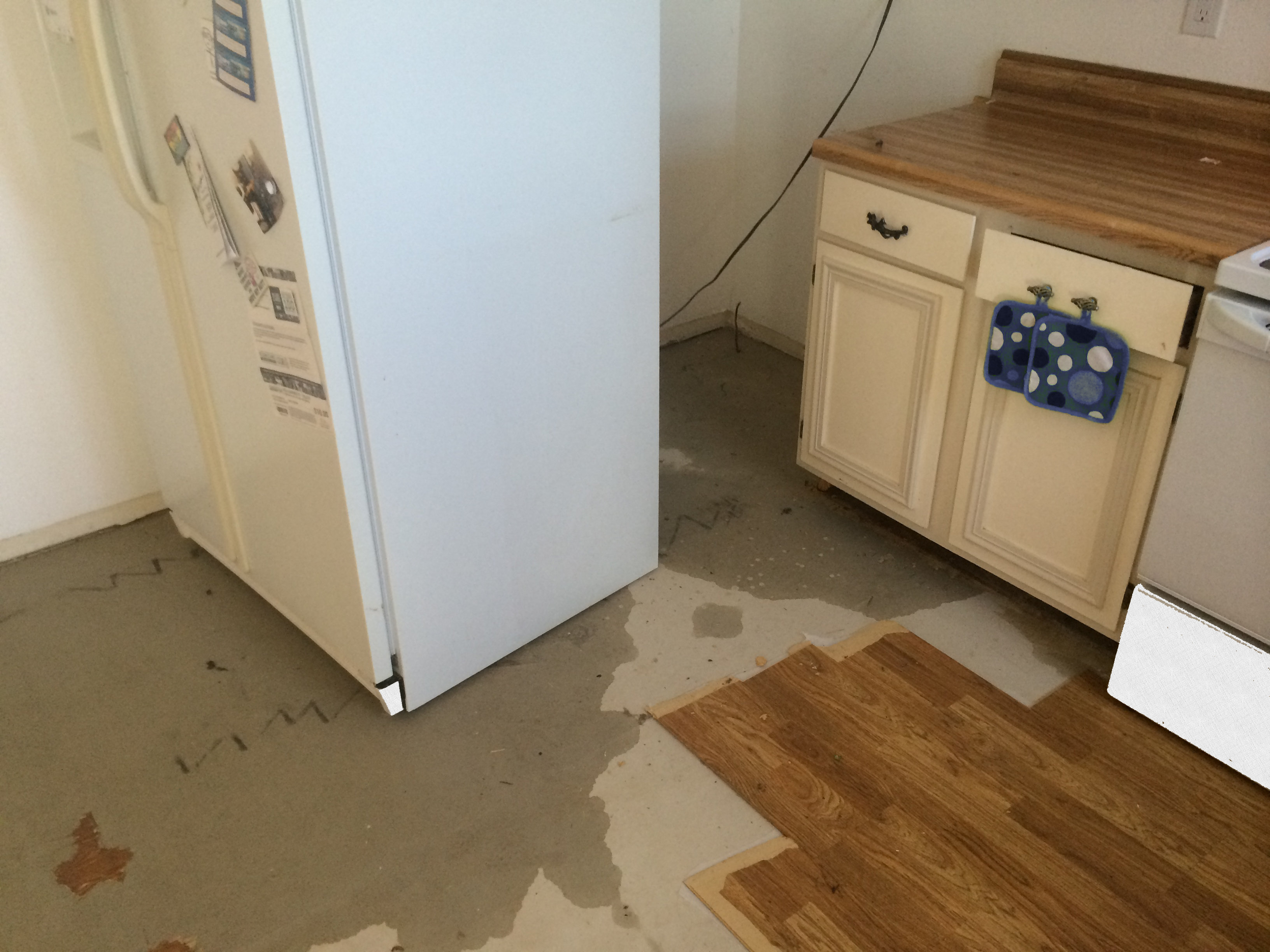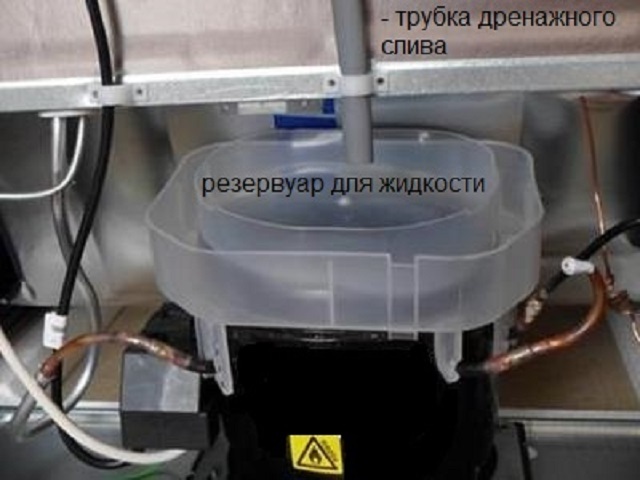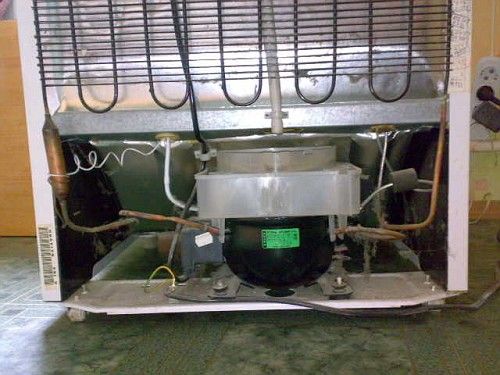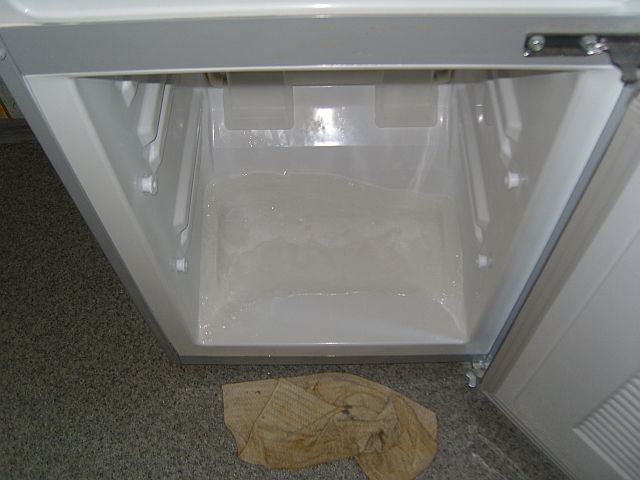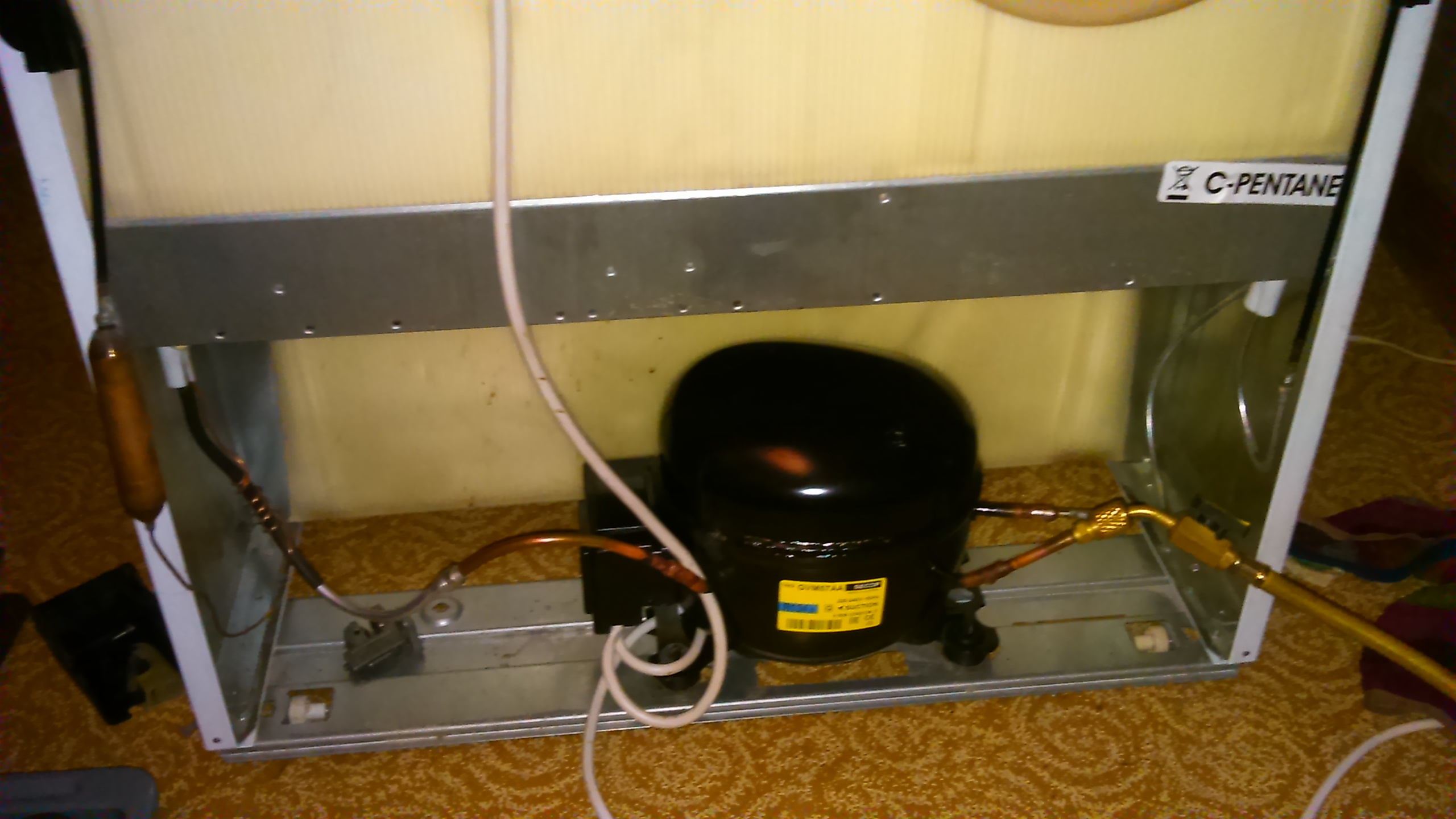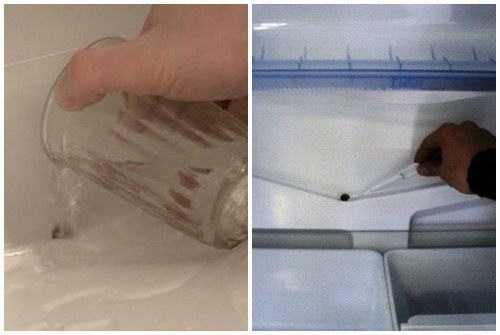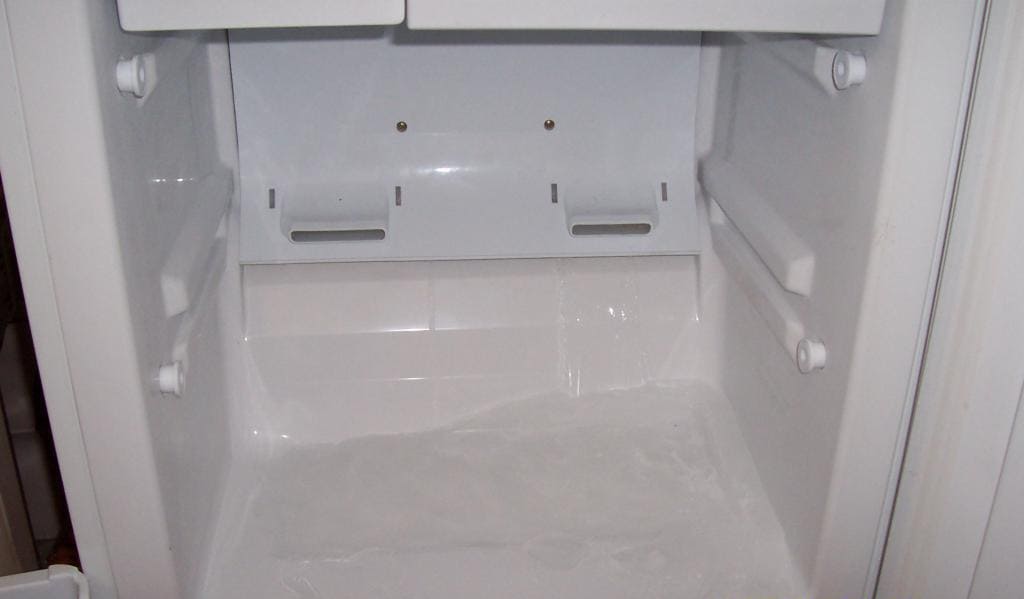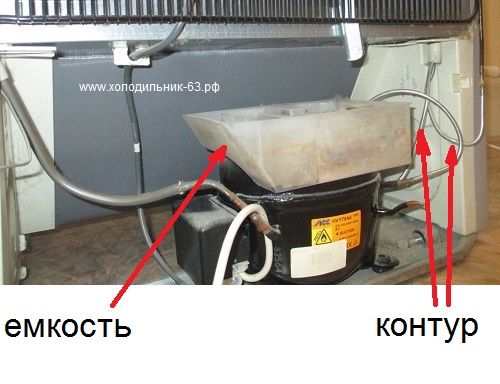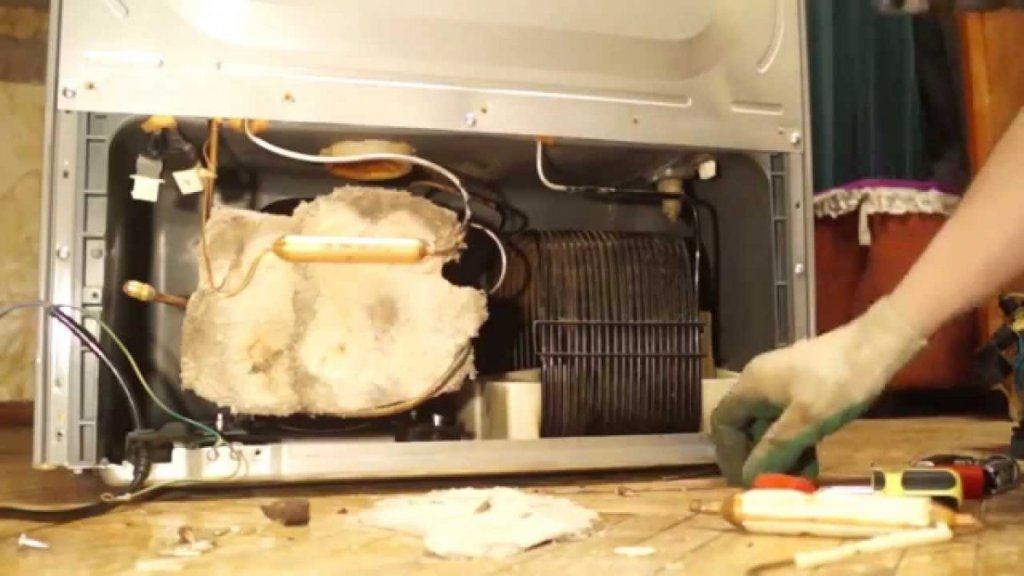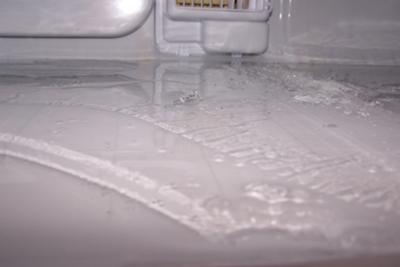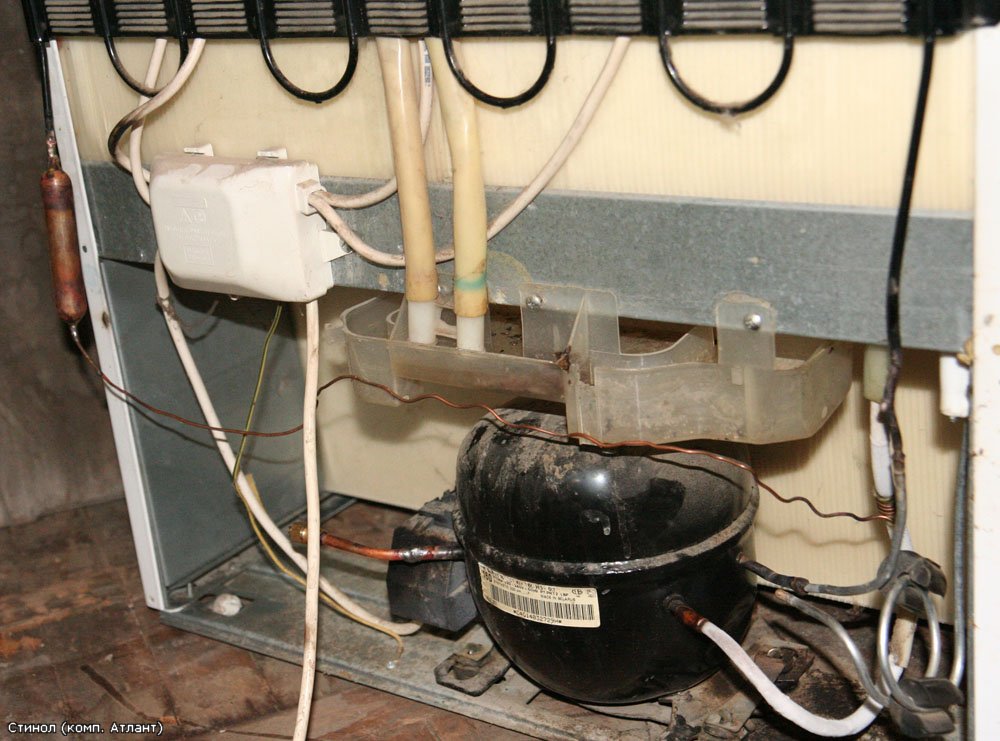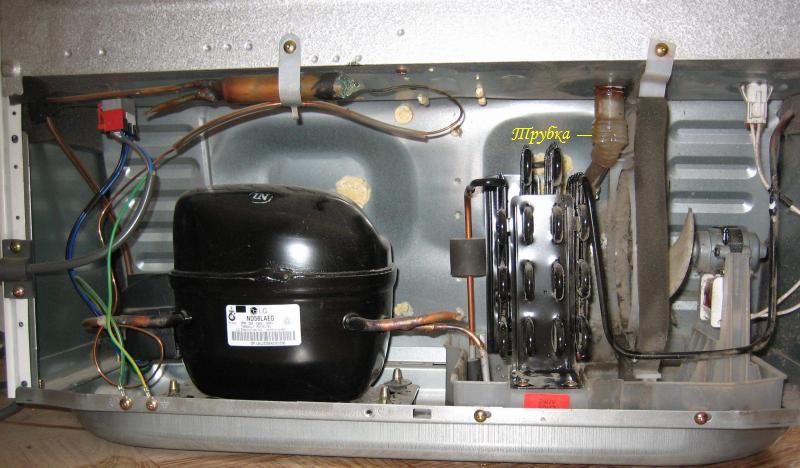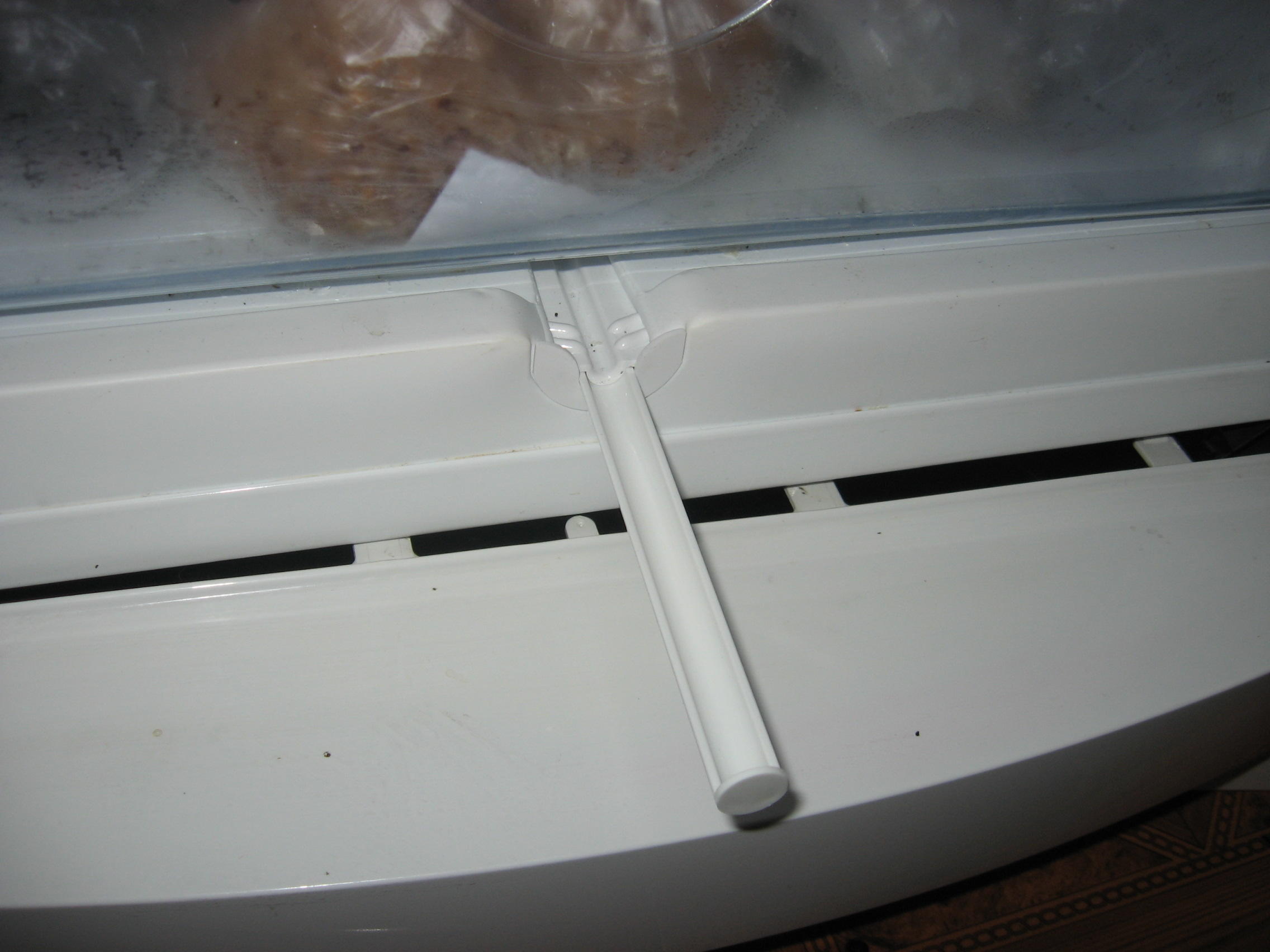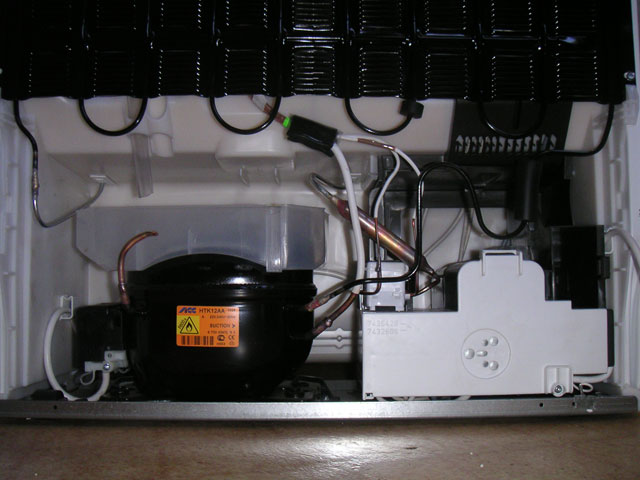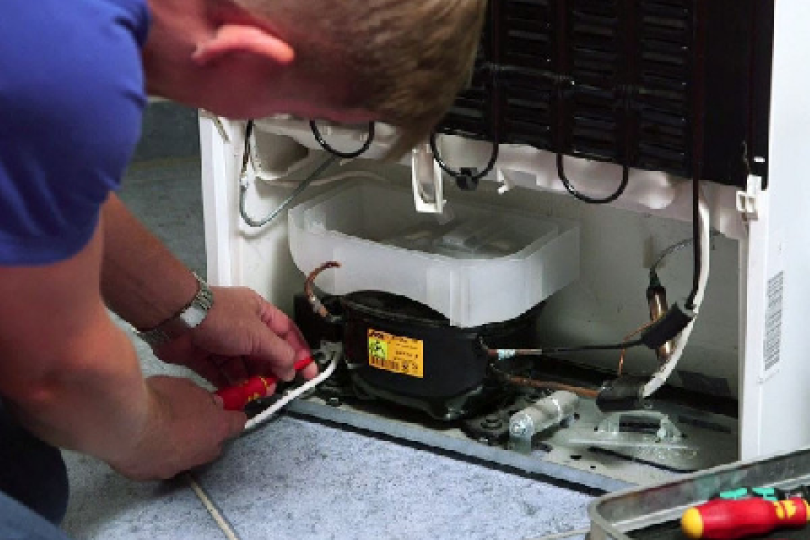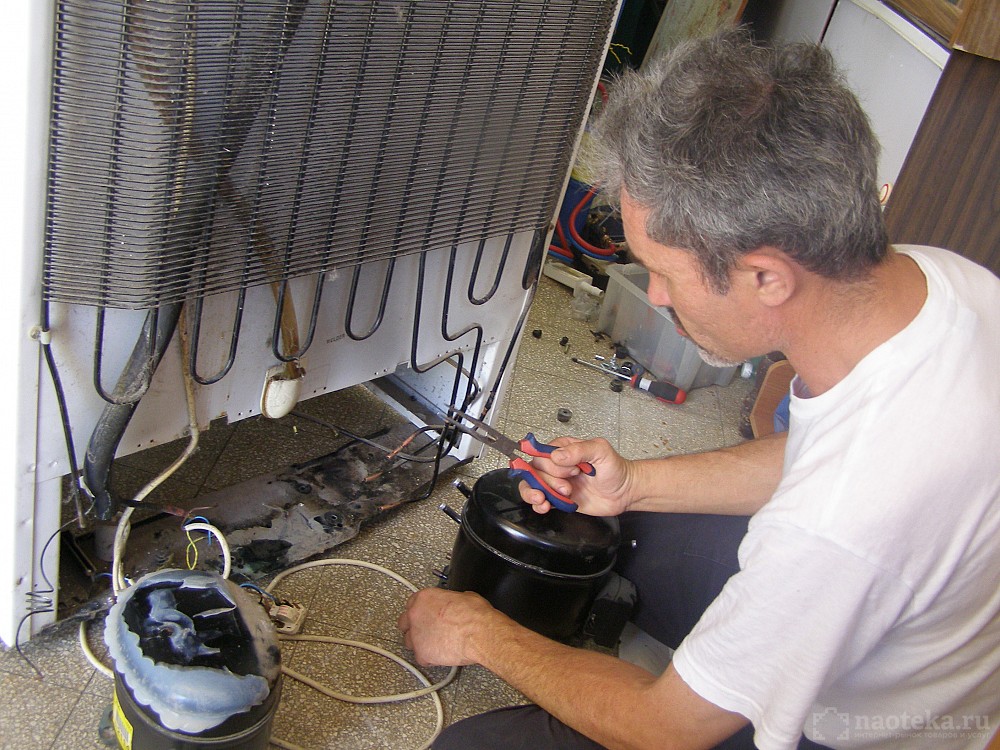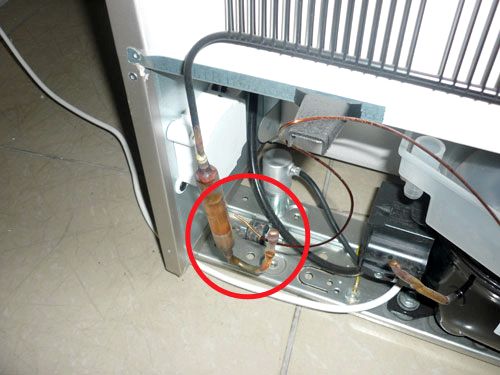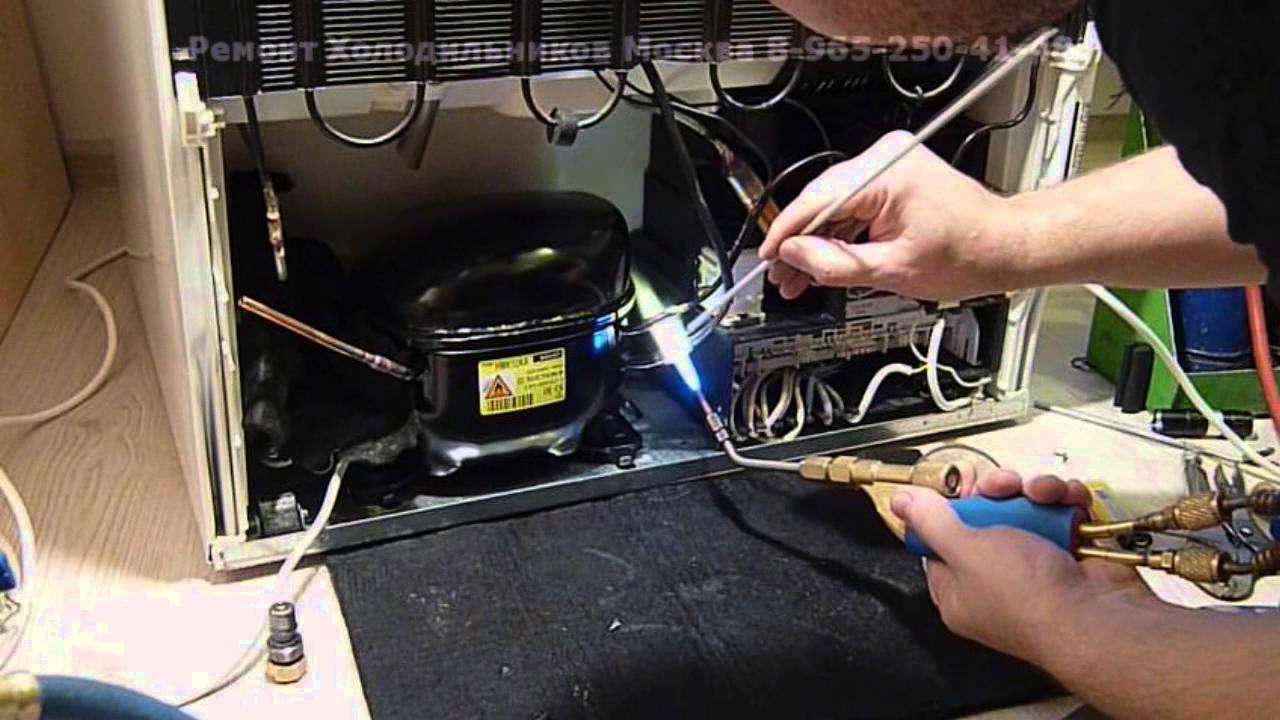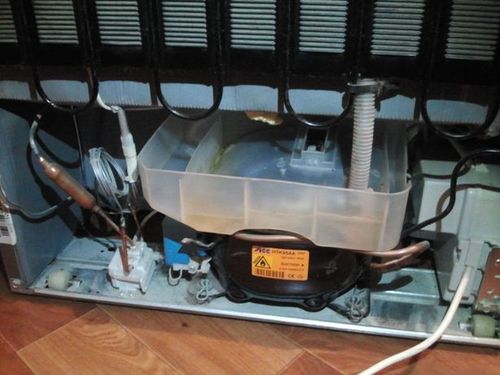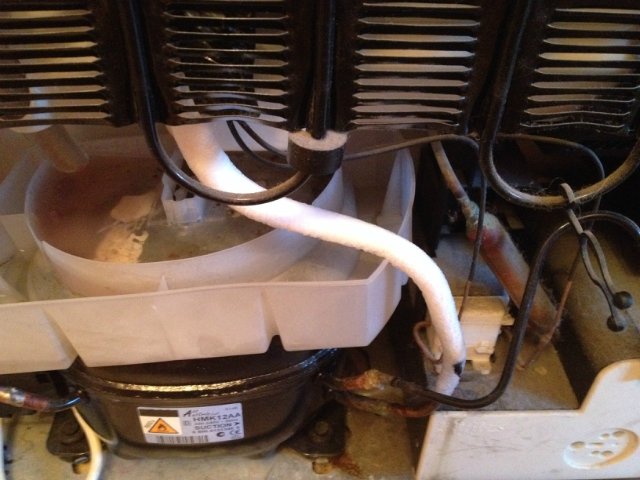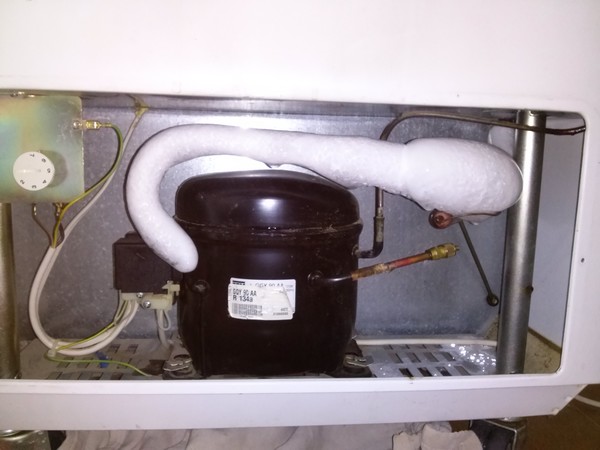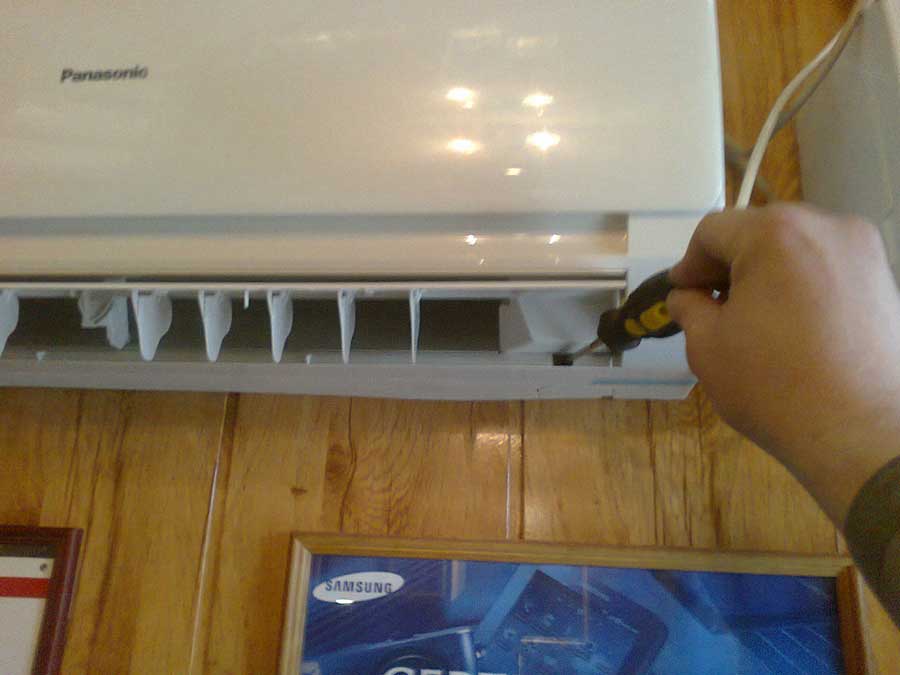Broken or cracked reservoir
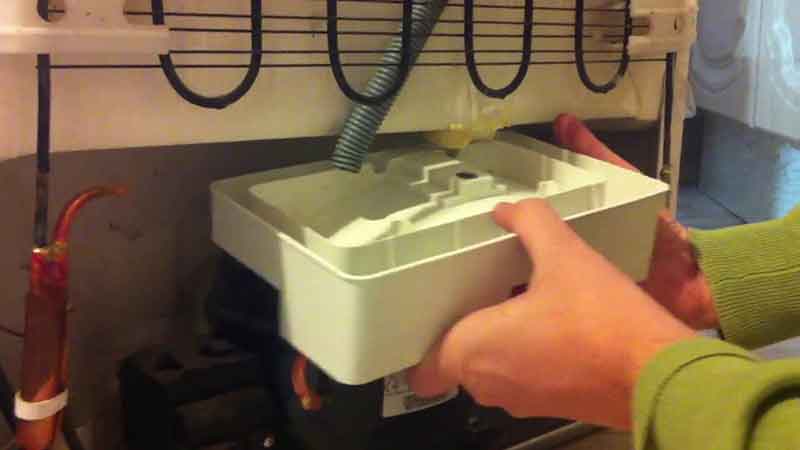 The water tank is located above the compressor
The water tank is located above the compressor
If refrigerators are flowing from below, a cracked reservoir is often the cause. In "crying" units, condensate flows down the drain pipes into a container for collecting liquid, which must be emptied periodically
In case of careless movement of the refrigerator or other errors in operation, the container may crack. At the same time, it is dry inside the chamber, moisture accumulates only under the refrigerator, especially at its rear wall.
It is not difficult to notice the damage, it is necessary to remove the reservoir and inspect. If you seal the tray, the problem will disappear only for a while, so it is recommended to replace the part with a new one.
7 reasons why the refrigerator leaks
Let's consider the main reasons that a leak has appeared in the refrigerator:
- the drainage hole of the refrigerating chamber is clogged;
- the drain hole of the freezer compartment is clogged;
- there is a crack in the container for collecting liquid;
- the drain tube has malfunctioned;
- there was a problem with tightness;
- there was a breakdown of the thermostat;
- in addition, in the No Frost system, there is a malfunction of the heating element of the evaporator.
Refrigeration chamber drain plugged
If liquid accumulates at the bottom of the refrigerator compartment, under the vegetable drawers, this indicates a blockage of the drainage hole. In drip-type units, there is a groove for moisture drain under the evaporator. Condensate flows into it and through a system of pipes is discharged into a special tray located at the bottom of the unit.
When the system is clogged with small debris, water flows down the inner wall. The hole becomes icy during cooling. If the problem is not corrected in time, it will lead to freezing of the evaporator, loss of performance, and an increase in the compressor duty cycle.
The problem can be easily fixed - just flush the drain with warm water from a rubber bulb to create excess pressure.
Freezer drain plugged
Water flows straight out of the freezer, there is abundant ice and moisture inside. The reason - the drainage hole of the freezer is clogged, excess moisture has nowhere to go.
Refrigerators with full No Frost have one evaporator located in the freezer. If the drain tube is clogged, liquid will accumulate inside the chamber. To clean the system, the inner rear wall must be removed.
Cracked fluid container
What is the reason if there is a puddle under the refrigerator, but at the same time it is dry inside?
In “crying” models, the condensate, flowing down the drainage system, enters the tray for collecting the liquid, which must be emptied periodically. In case of improper use - for example, careless movement of equipment from place to place - a crack may appear in the container. It is not difficult to notice it, you just need to pull out the container and inspect it. You can, of course, glue the broken part, but the problem will repeat after some time. Better to buy a new tray.
Drain tube problems
All of the above signs are also observed when everything is in order with the container, but the drain tube has burst or simply shifted and does not provide tightness.
You can try to put it back in place yourself, but this is fraught with a break in the part. It is better not to risk it, but to entrust the matter to a specialist.
Leakage problems
Leakage occurs when the seal is worn or deformed - a rubber part that ensures a tight fit of the door to the body. Loose closure, the appearance of gaps leads to a constant flow of warm air.
The temperature of the inner chamber rises, water droplets condense on cold surfaces, without having time to evaporate.Ice builds up on the back and around the freezer and overflows the drain when thawing. A puddle forms under the refrigerator.
Do not try to replace the seal yourself. Tightness can be achieved only by the correct selection of the part, reliable fixation, strong connection of the joints with a mounting hairdryer.
Broken thermostat
During normal operation, a thermostat (temperature sensor) monitors the temperature by giving the compressor on or off signals. In modern two-compartment refrigerators, each compartment has its own thermostat. In the event of a breakdown of this part, the information about the temperature regime does not reach the compressor, or the control unit.
The main symptoms of a malfunctioning thermostat:
- the engine runs continuously;
- the temperature is increased;
- puddles on the floor and inside the chamber.
It is not recommended to change the thermostat on your own and, moreover, you should not trust such work to random craftsmen. This is a very complex operation that can only be performed at a service center.
No Frost system
In the No Frost models - cooling of food by means of forced circulation of cold air. Due to the even distribution of the cold, there are no low-temperature zones in which moisture could condense and form ice.
The evaporator is located behind the rear wall, above it there are fans for the "know frost" effect. Excessive moisture freezes on the evaporator. During the compressor rest cycle, it thaws and flows through a system of drainage channels into the reservoir, where it naturally evaporates.
If the No Frost refrigerator is leaking, in addition to all of the above, the cause may be a malfunction of the evaporator heater. This can be determined by the freezing of ice inside the freezer.
Possible causes of problems with the refrigerator
The puddle is most likely the result of the following circumstances:
Drain pipe came off. The result will be water not entering the tank, but directly onto the floor.
A symptom of this problem is water under the appliance, while in the middle it is dry and there is no frost.
To solve the problem on your own, you need to move the refrigerator and slightly adjust the drainage drain tube at the bottom of the device, since it could move from its place as a result of moving or moving from apartment to apartment.
Fluid reservoir is broken or cracked.
Water can indicate this breakdown, especially on the back of the appliance, while the inside remains dry.
In order to solve the problem, you need to move the refrigerator a little. If the problem was really due to a cracked reservoir, then it will be noticeable with the naked eye. In this situation, it is likely that the reservoir will need to be replaced. To do this, you need to seek qualified help.
The evaporator heater in the refrigerator with the No Frost system is broken.
A sign of this problem may be the presence of moisture underneath the appliance, or a large amount of snow in the freezer.
The only correct way out is to completely replace the evaporator heater, otherwise such a malfunction can lead to a complete breakdown of the device. Since the situation indicates a violation of the technological processes of the No Frost system, this leads to an increase in the level of humidity and increased formation of ice. Each time the refrigerator is opened, the ice melts slightly and the liquid flows down the drainage channel into the tank, which is not intended for such an amount of liquid.
The drain hole in the refrigerator compartment is clogged.
The presence of this problem is indicated by moisture, both in the middle of the device and outside. Most often, moisture accumulates under the drawers for vegetables and fruits, and with a large amount of liquid, it comes out and accumulates under the appliance.
It is quite possible to eliminate this situation on your own.Usually, this problem occurs in cases of clogging of the drainage hole with crumbs, food particles.
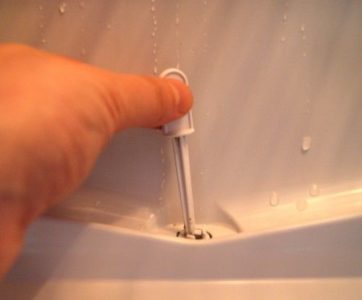
We recommend that you familiarize yourself
To understand the situation, you can try to pour water under some pressure, for example, from a syringe without a needle.
In order to avoid this situation in the future, do not put food close to the back of the appliance.
The refrigerator door does not close tightly enough.
This problem is indicated by the presence of water both inside and outside the appliance.
This situation occurs as a result of the following. The door does not close tightly, as a result, moisture forms inside, which melts slightly when the door is opened. The liquid begins to collect in the sump and overflows it.
You can solve this issue by leveling the door, or by installing the device according to the level. If these measures turn out to be ineffective, it means that the seal is worn out and must be replaced as soon as possible.
The refrigerator seal is worn out.
A sign may be the presence of liquid, both in the middle and outside of the refrigerator. In this situation, the appliance freezes the food, a little frost and ice forms, and as a result of frequent opening, thawing begins. In this situation, the only way out is to replace the seal.
Of course, each device has its own characteristics, and its reliable service life depends on various factors. However, it should be remembered that respect for household appliances will make their service life longer.
Troubleshooting, repair
If you decide to do without the help of a wizard and troubleshoot yourself, then you should be careful, if you do wrong, you can only make it worse. Warranty service does not apply if you were doing repairs at home on your own.
If a leak begins at the bottom of the washing machine, then you should perform the following steps one by one in time on your own:
- turn off the equipment from the power supply. Unplug the machine from the outlet carefully, and do not allow water to come into contact with you. This will prevent possible troubles, primarily electric shock. If you cannot make a shutdown without contact with water, then you should turn off the entire electricity system in the switchboard;
- as soon as a leak occurs, turn off the water supply;
- as the washing machine is turned off, open the door, remove all clothes from the washing machine. At the end of the wash, you should drain the remaining water from the machine through the drain filter, which is at the bottom, in front of the washing machine, at least for LG.
Then we proceed to the detection and elimination of the resulting breakdown. If the hoses are damaged, after finding the place of leakage, you can begin to eliminate the hole (if you decide to repair, and not replace the hose). The hose can be repaired with a waterproof glue and a rubber patch. If it turns out that the problem lies in the gasket between the hose and the body, then you should unscrew and release it. Then replace the old gasket with a new one purchased in advance. After the manipulations, assemble the structure back.
If it turns out that the problem is related to the dispenser and the equipment is leaking, it means that it is necessary to eliminate the malfunctions in it. Remove the dispenser from the device, clean it properly, if a blockage is found, remove it. Then you need to return the dispenser back and test the operation of the equipment. It is necessary to check how strong the pressure is, if necessary, slightly close the inlet valve, loosening the pressure. If all these manipulations did not help, this may mean one thing - the inlet valve is badly damaged, it can only be repaired by a specialist in the repair of washing machines.
Another reason for the leakage of the washing machine may be the loss of integrity and elasticity of the main cuff, which is installed on the loading hatch.To check the integrity of the cuff, whether it is leaking, you need to open the hatch to examine the condition. If minor damage is found, they can be repaired with waterproof glue and rubber patches. Remove the clips-clamps and the place that was patched, move to the lower part of the hatch, and then return the clips into place. If it turns out that the cuff is badly damaged, then you need to order a new one replacing the old one.
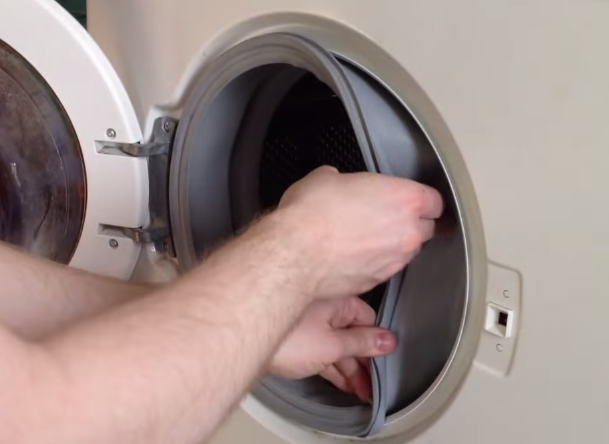 Replacing a damaged sealing lip
Replacing a damaged sealing lip
If you decide to check and repair the inlet valve pipe, then you will need to remove the top cover of your washing machine, then start examining the part. If the condition of the pipes has visible damage, or the pipes have acquired an appearance that differs from the norm, then they should be replaced, which means that the pipe is leaking. A branch pipe of this type is a complex part that will be replaced by a qualified technician. The filler pipe of the washing tub may also break. Check if there is water at the junction, which means you need to disconnect the filler pipe, remove excess glue, remove all liquid and dry the junction thoroughly. Then return the pipe to its place, while fixing it with high quality waterproof glue. For these purposes, you can also use an epoxy mixture.
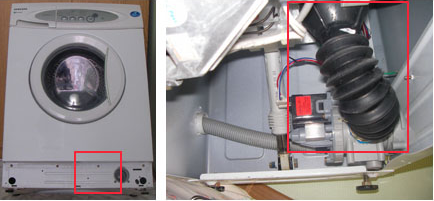 If the drain pipe of the tank has leaked, you will need to seal the leak with rubber or change it
If the drain pipe of the tank has leaked, you will need to seal the leak with rubber or change it
You will need third-party help to fix problems with the tank. Let the assistant tilt the washing machine and hold it, then you can examine the general condition of the bottom of the machine. If equipment is loaded from above, then the side wall should be inspected. The purpose of the inspection is to detect traces of liquid. If water is found on the wall or bottom, then the problem is definitely related to the operation of the tank. This is one way out - call a specialist, it is impossible to repair the tank on your own, if it leaks.
The main causes and methods of their elimination
So, a puddle has formed under the refrigerator. It is naive to believe that it will disappear as suddenly as it appeared.

You will have to make every effort, but first limit the range of troubleshooting:
- malfunction of the evaporator;
- drainage is leaking;
- the tightness of the condensate collection tank is broken.
Drainage tube disconnected
When the refrigerator is inspected from the inside and outside, but no traces of liquid are found, the drain tube may well be the cause of the leak. If it jumped off the branch pipe on the condensate collection tray, then the incoming moisture flows freely down to the floor, where it accumulates in the form of little aesthetic puddles.
Broken (or badly cracked) fluid reservoir
The next "culprit" is the refrigerator tray, into which condensate should be collected. It is made of plastic and for a number of reasons may well crack, become unusable. And here nothing can be done - a replacement is needed.
Broken evaporator heater
Modern units have a special function that prevents freezing (Know Frost). Therefore, they do not need to be periodically defrosting, cleaning the freezer from ice collected on the walls. But, if the evaporator heating device is out of order, the refrigerator instantly loses its "magic" properties, the liquid through the drainage system enters the melt water collection tank, which has a small volume. As a result, the tray fills up and moisture accumulates under the bottom. Verdict: the device needs to be replaced.
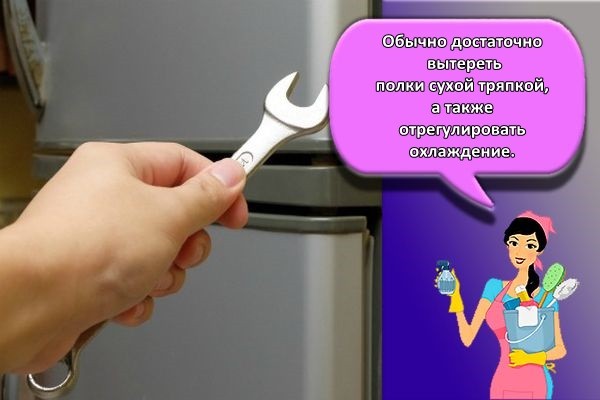
Freezer compartment drain plugged
Finding themselves in the kitchen, the owners are amazed to discover that the refrigerator is leaking. But even this nuisance is not a reason to despair: perhaps a hole in the freezer is clogged, through which condensate is drained in the unit. The diameter there is small, so the line often suffers from debris that gets into it.
The drain hole in the refrigerator compartment is clogged
A clogged condensate outlet in the main chamber of the unit is another likely root cause of the wet business. After cleaning the hole, the refrigerator starts working without interruption. And there will be no more puddles on the floor.
Appliance door does not fit snugly against the body
A pressurized door that is open for a long time, especially if it does not fit well along the contour, is a common problem, as a result of which the refrigerator will start to "cry". The explanation is simple: the temperature difference inside and outside leads to condensation of cold air, the appearance of leaks. And already the very incorrect closing of the door can occur due to the destruction of the sealing gum, incorrect installation of the refrigerator legs.
The refrigerator is not properly installed
Initially incorrect or after rearrangement the position of the refrigerator will inevitably lead to malfunctions. This is a poorly closing door, a skewed condensate collection tray.
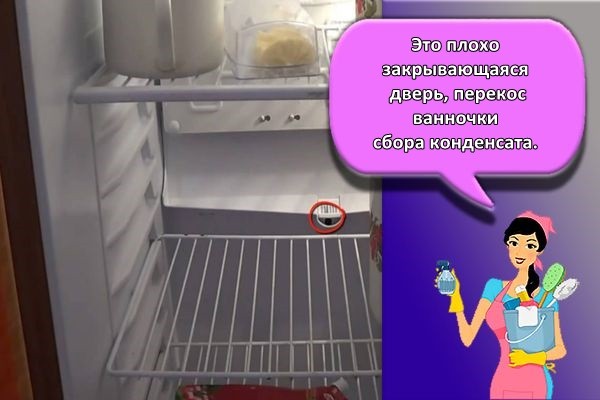
The adjustment of the legs on the bottom is not in vain: it must be done so that the door closes under its own weight. But at the same time, it is also not recommended to overfill the unit unnecessarily.
The seal is damaged
There are no eternal things, therefore, if there is a problem called the "poorly closed door" of the refrigerator, its root should be sought in the destruction of the rubber band laid along the contour. The replacement is carried out by a master invited to the house.
Freon leak
In "older", long-running units, over time, there is a leakage of the refrigerant - freon. It will not be possible to cope with it on your own - you need to call a service specialist. In addition to replenishing the gas supply, he will check the line, the evaporating circuit for leaks and, if necessary, eliminate the gust.
Oil leak
The compressor breaks down rarely, but “aptly”. Apart from malfunctioning, one sign of a problem with the appliance is brown spots under the refrigerator. Self-repair is not recommended, since there is a high probability of failure to perform it efficiently.
Damage to the thermostat
Almost immediately after the failure of the temperature control unit, a breakdown of the compressor follows, which cannot withstand operation in forced modes. The first signs: puddles inside the refrigerator, no indication on the display, or the warning lamp does not light up.
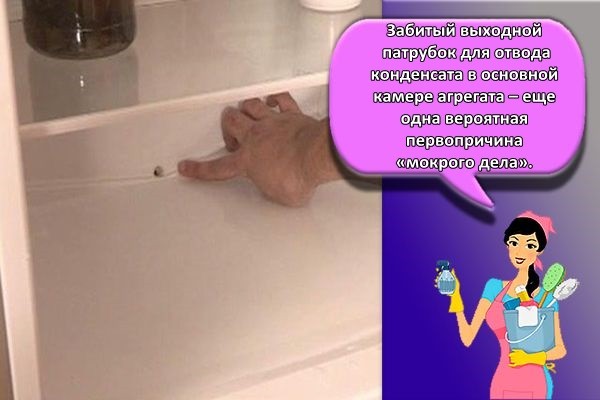
Leakage reasons
There are several main reasons why the washing machine is leaking from below, here are the main ones:
- improper use of washing equipment;
- use of low-quality chemicals for washing;
- factory defect in the manufacture of parts or elements;
- failure of a part or element.
When the device is completely emptied, then you should understand where the cause of the leak is, what kind of breakdown occurred. It is better for a master to make diagnostics. Let's consider what are the reasons in more detail and how to determine their occurrence if the washing technique is leaking.
Inlet or drain hose
A washing machine is a device that constantly works with liquid substances; it contains hoses. It is not difficult to identify a cut or crack in the hoses if they are leaking, and this can be done even with a non-working machine. You can wrap the hose with toilet paper, where it gets wet, there is the damage that led to the leak. If it turns out that a leak has arisen at the junction of the hose and the body of the washing machine, then dismantle it from the body and replace the gasket. If it turns out that a leak has arisen on the hose itself, then it must be replaced completely, the repair will either be of poor quality, or will save it from the leak for a short time.
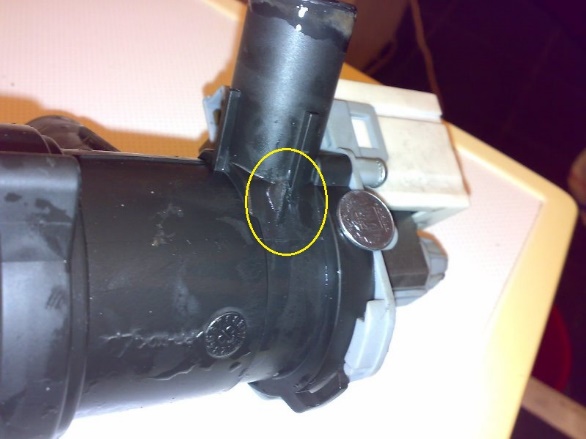 Leakage through drain sediment
Leakage through drain sediment
Dispenser
If the washing machine leaks when you turn it on, after filling in with water, it may mean that the detergent dispenser has broken. This can happen when using a poor-quality chemical agent, poor water, or when clogged with powder or due to the powerful pressure of water. Also, a foreign object may enter the tray or it may simply become clogged with powder.
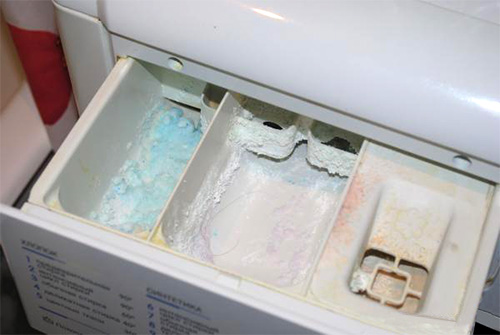 Leaking powder tray
Leaking powder tray
Pipe branch
The branch pipe may break after 12 months from the beginning of the operation of the washing machine, it happens less often with LG machines. This breakdown is connected with unscrupulous manufacturers who are trying to save money on everything.
It happens that the drain pipe starts to flow, going to the drain pump from the tank. You can verify this by tilting the washing machine and looking from below. The branch pipe for filling the water into the tank may also begin to leak. To check this, you will have to untwist the front wall and inspect the junction. To eliminate the problem, you will need moisture-resistant glue, which you need to thoroughly lubricate the connection point of the branch pipe.
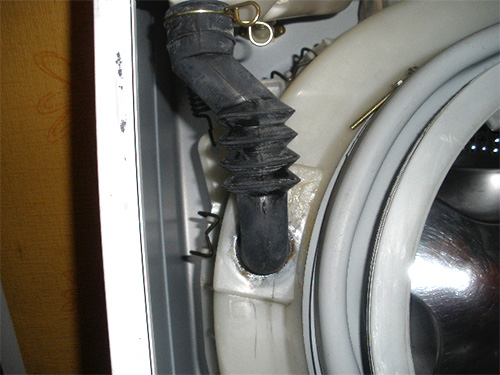 Branch pipe for filling water into the tank
Branch pipe for filling water into the tank
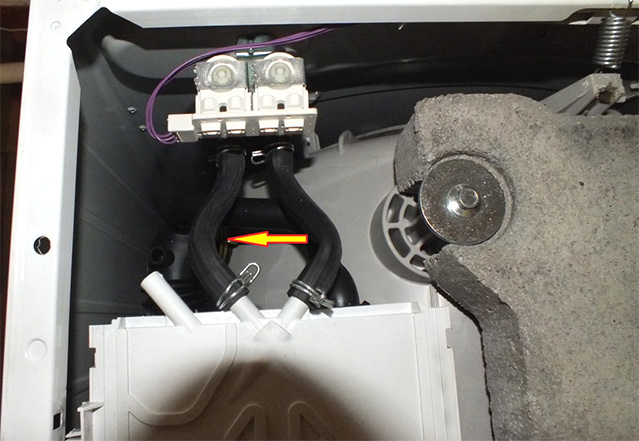 Leakage through nozzles
Leakage through nozzles
Door cuff
If water leaks out of the hatch where clothes are loaded, then the sealing cuffs are damaged. It can be repaired or replaced; for a quality repair, you should call a master. To avoid such damage, carefully check the pockets of your clothes before loading them into the washing machine. Small items often remain in pockets, which with pointed edges can damage the cuff and lead to leakage.
Minor cuts in the cuff can be repaired with a patch of rubber and waterproof glue. If the damage is large, a complete cuff replacement will be required.
 Cuff leak
Cuff leak
Tank
Problems with the tank can arise if you often wash not only clothes, but also shoes, belts, clothes with metal elements, which gradually damage the surface of the tank and lead to breakage. If a crack appears in the tank, then it will have to be changed, and this will take money and a lot of time. You can try to seal the crack, but more often than not, this does not end well.
The tank consists of several parts, which are connected using brackets or bolts, with a gasket connecting them. Over time, the gasket is damaged and then a leak occurs, after which it may be necessary to replace the gasket.
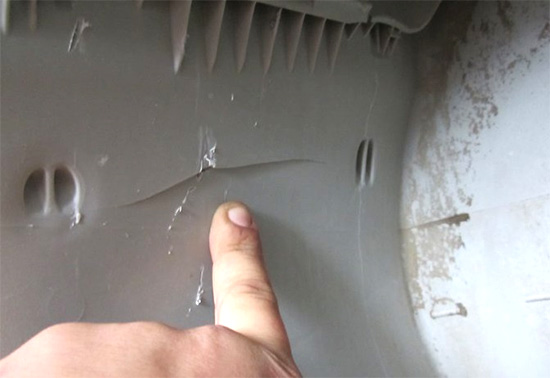 Crack in the tub of the washing machine
Crack in the tub of the washing machine
Stuffing box
If a leak occurs during spinning, it means one thing - the oil seal is damaged, immediate repair is needed
It is important to remember that the oil seal will wear out over time, which immediately leads to leakage during the spin cycle. To check the condition of the oil seal, you need to inspect the tank
By the way, during the inspection, there may be a need to change not only the oil seal, but also the bearings.
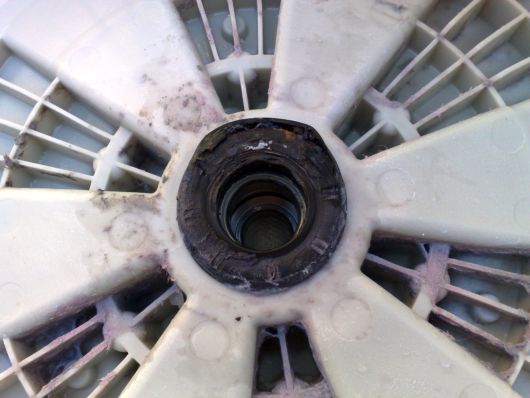 Leakage due to bearing wear
Leakage due to bearing wear
Causes and elimination of water in drip-thaw refrigerators
A common reason for the accumulation of water in the refrigerator under the plastic vegetable drawers is a clogged drain hole or drain tube located on the back of the refrigerator.
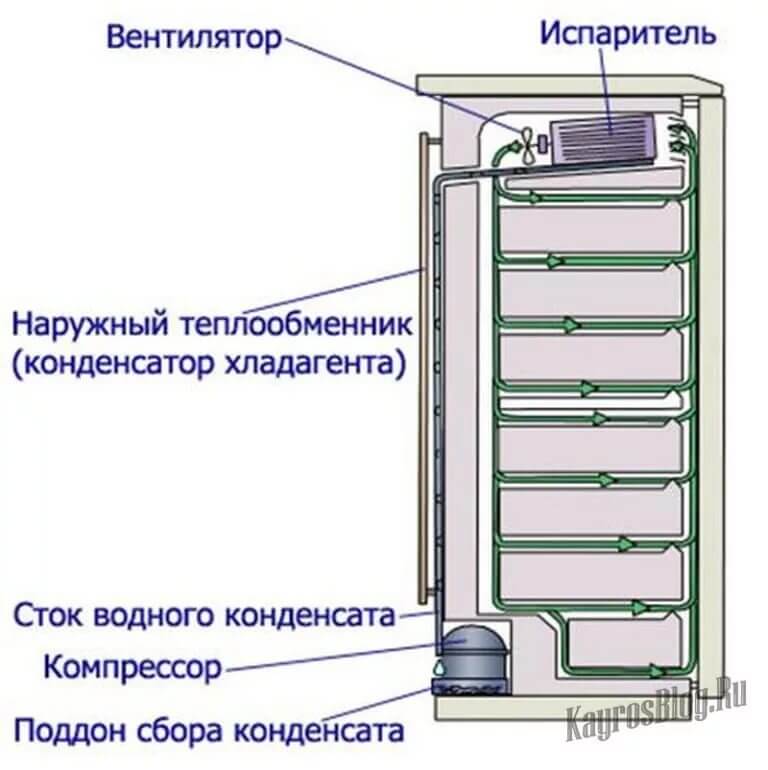
Refrigerator circuit with drip thawing.
How to clean the drain hole of the refrigerator with your own hands
A blockage can form due to the ingress of crumbs, food debris and dust into the drain, which are washed off the back wall by drops of water when thawing or when the tube freezes. After a while, you will be able to see the refrigerator leaking.
If the blockage is not removed in time, an unpleasant odor will appear in the chamber, and the evaporator will begin to be covered with ice. Since ice is a good heat insulator, the compressor will have to work almost non-stop in order to restore the set temperature regime. This is what the drain hole looks like. The arrows show how the water is drained from the rear wall of the unit and where it enters.

To get rid of the smell and restore normal operation, it is necessary to clean the drain hole and the hose as soon as water appears, without delaying it. Two cleaning methods are used depending on the cause of the blockage.
Method one
- The refrigerator is disconnected from the mains;
- Drawers for vegetables and fruits are removed;
- If there is no ice near the drain, clean it with a cotton swab.Instead, a knitting needle or a cocktail straw wrapped in cotton or soft cloth will do. Sometimes a cleaning device is included with the refrigerator;
- Warm water is drawn into the syringe and injected into the drain. If it boils in the tube and flows freely into the container, the clogging is eliminated.
- If the water cannot flow, it means that the tube is frozen or the blockage is deeper.

Method two
The unit is de-energized and left for 10 - 12 hours with the doors open. After defrosting, cleaning is carried out according to the first method.
If the blockage remains, clean it with a long wire of a suitable diameter. In our case, we took not a wire, but a sling (such slings are used to pack equipment, furniture, and so on.

The procedure is carried out with the utmost care so as not to damage the drainage tube and not to scratch the lining plastic

We push the wire or sling into the hole so that the end of the sling comes out on the other side of the refrigerator:

Cleaning is carried out not only from the top of the chamber, but also from the bottom of the compressor. After such cleaning, the blockage is guaranteed to be removed.
For prophylaxis and flushing of the tube, you can place a jar under the end of the tube and pour some water from a glass into the hole. If you clean the hole well, all the water will be in the jar. Dirty water, mind you!

In the video - cleaning the drain hole in the refrigerator with drip thawing:
If water has accumulated in the refrigerator
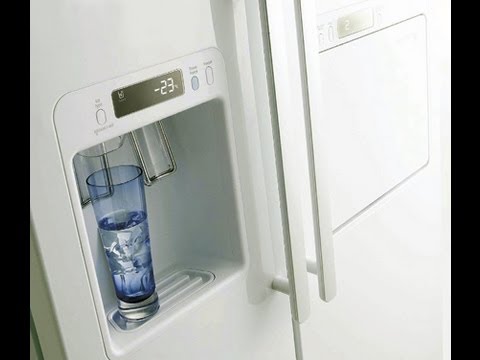
Installing the refrigerator not according to the instructions
If the unit is incorrectly installed, the door will not close tightly, therefore warm air flows into the chamber. At first, this will cause an increase in the volume of water drained through the drain hole, which will lead to an overflow of the tray. As a result, a puddle will appear under the refrigerator to the accompaniment of the murmur.
As the ice crust builds up on the evaporator, the compressor stops less and less and the drain hose freezes over. To get rid of the problem, twist the legs, set the unit vertically, checking the position with a building spirit level or a plumb line.
Water will flow to the floor when the container is deformed or displaced. Displacement of the drain tube is also possible. The manual supplied with the unit indicates the location of the tray (usually at the back). If it is deformed, then it is put in place. Otherwise, a new tray is purchased and installed to replace the damaged one.
Seal wear
The rubber seal can be accidentally damaged, deformed or simply worn out, which causes cracks to form through which warm air enters from the outside. Further, according to the already familiar scenario: the compressor breaks down, the drain pipe freezes, and water flows from the refrigerator. The problem is solved by replacing the gum on your own or by a specialist. The reason may be a skewed door. In this case, you just need to adjust its position.
If the temperature sensor breaks down, the refrigerator turns off with a delay or works without interruption. Further events develop according to the already familiar pattern: the build-up of ice on the evaporator, freezing of the tube, and when it stops, water collects.
In this case, only the replacement of the temperature sensor will help. Water will appear on the shelves because food is placed close to the back wall. Therefore, some of the moisture condenses on them, from where it flows onto the shelf.
Drainage system malfunction
This reason for leaks can be both in models with No Frost, and in simple drip refrigerators. In this case, puddles can form not only on the floor, but also inside the chambers - it depends on which element of the drainage system is faulty:
- cracks in the fluid reservoir - it is in this container that condensate collects before evaporating; if this is the problem, the tank must be removed from under the freezer and replaced with a new one;
- the drain hole is clogged - it is located on the back wall in the refrigerator; the main symptom in this case is that a puddle forms inside the refrigerator; in case of clogged drainage, the hole must be thoroughly rinsed with a stream of water or cleaned with a cotton swab;
- problems with the drainage drain tube - it connects the drain hole and the water tank, or it is punctured and leaks, or it just came off; it is not difficult to fix the problem - move the household appliance away from the wall, fix the tube and check the tightness of the connections.
A special case if oil is leaking from the refrigerator, not water. The lubricant is used in the compressor - the main device of any refrigerator, and at the same time the most fragile. Compressor leaks occur even with slight shaking or transportation of a household appliance in a lying position.
Unfortunately, if the reason for the leakage of even a new refrigerator lies in the damage to the compressor, it will not be possible to do without the qualified help of a specialist. But it is not difficult to avoid expensive repairs - you need to familiarize yourself with the instructions for using the refrigerator in advance and strictly follow it.
The drain holes in the refrigerator compartments are clogged
A common cause of poor refrigerator performance is clogged drain holes in the freezer and refrigerator compartments.
Consider these situations and ways to eliminate leaks:
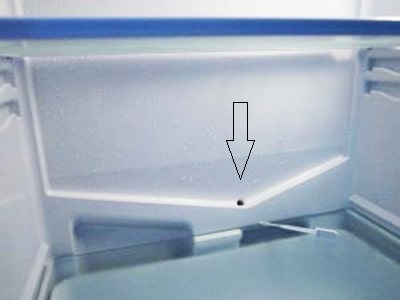 |
When the hole in the freezer becomes clogged, water begins to flow into the common compartment (if it is located below), excess ice appears near the door. To solve the problem, you first need to completely defrost the refrigerator. If after this procedure nothing has changed, then you will have to remove the back wall of the freezer. There is a reservoir for excess fluid and a drainage tube. The hole must be carefully cleaned, taking care not to damage the channel itself. It is advisable to entrust this procedure to professionals. |
| The refrigerator compartment drain is usually clogged with crumbs from stored food. As a result, water appears inside, on the floor, and ice forms abundantly in the chamber. If you decide to deal with the blockage yourself, you can use a syringe filled with warm water. The pressure of water from the syringe should push the blockage out. Otherwise, it is better to contact a master. |
Bottom leak
If you do not understand why the refrigerator is flowing from below, then we remind you once again that the drained condensate accumulates on the evaporator - a plastic container that heats up from the compressor. A leak from the bottom indicates that this container is overfilled, broken, or crooked. In this case, water can only flow from below, and inside the chambers it will be dry.
In order to understand exactly why the refrigerator is flowing from below, it is necessary to unfold it and inspect the compressor. It is usually located at the back of the household appliance and located at the bottom. An open container can adjoin it, be installed either from above, or end-to-end (it all depends on the model). Many containers (evaporators) are simply glued to the compressor, and when the glue comes off, the evaporators themselves come off, as a result of which the water from the drain hole simply drips onto the floor. This is where the leak occurs. Also, the evaporator can simply crack, and water will flow through the crack to the floor.
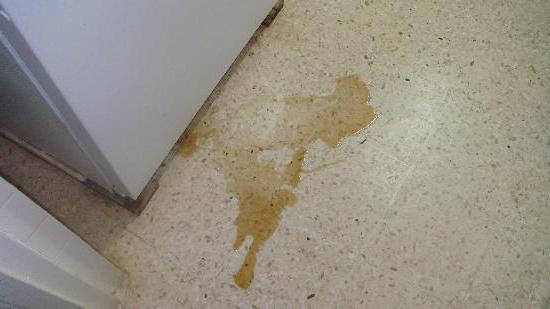
In some cases, water under the refrigerator appears due to the fact that condensate flowing into the evaporator simply does not have time to evaporate. This is possible if the refrigerator is forgotten to close or is opened too often. This leads to a large amount of moisture entering the chamber, which then condenses in large volumes. In this case, simply remove the evaporator (if it is removable) and empty it. If it is firmly glued, then you can use a syringe to pump out all the water from it. By the way, an overfilled condensate container may indicate poor heating of the compressor. In turn, this indicates a loss of efficiency of his work.However, in this case, you will definitely notice that the device began to cool slightly, the presence of water on the floor will interest you in the last turn.
In any case, the condensate container (evaporator) is the main reason why water flows from under the refrigerator. There can be no other options. It's another matter when the refrigerator inside leaks.





